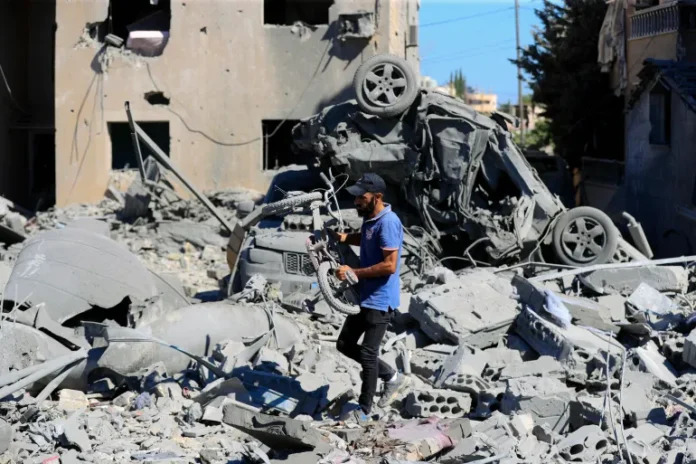When we think of war, we often imagine chaos and destruction. But war is far more strategic than it may appear on the surface. Israel’s recent conflict with Lebanon brings this to light. Tactics used in Gaza are now being employed in Lebanon, raising alarm bells among analysts and civilians alike. What does this mean for Lebanon? Are the people destined to experience the same fate as Gaza? Let’s dive into Israel’s strategy, how Lebanon is affected, and what the future may hold for this war-torn region.
What’s Happening in Lebanon Right Now?
Since late September 2024, Israel has ramped up its war efforts in southern Lebanon, mainly targeting Hezbollah strongholds. This is eerily reminiscent of Israel’s approach in Gaza, a region that has been nearly decimated by relentless airstrikes. The same rhetoric, strategies, and warnings used in Gaza are now being repeated in Lebanon.
But why Lebanon? The situation can be traced back to ongoing conflicts with Hezbollah, a powerful armed group that Israel sees as a significant threat. Like Gaza’s Hamas, Hezbollah’s presence and influence have turned southern Lebanon into a focal point of military action.
Tactics Borrowed from Gaza
One striking aspect of this conflict is how Israel has brought tactics honed in Gaza to the Lebanon warfront. Israel’s campaign in Gaza aimed to “eradicate” Hamas, which led to widespread destruction, including civilian homes, medical facilities, and essential infrastructure. The tactics were brutal, and now, we’re witnessing similar strategies in Lebanon. The comparison is impossible to ignore.
Warnings Without Clear Guidance
Israel’s military is issuing warnings to civilians, telling them to leave areas supposedly housing Hezbollah weaponry. But the vagueness of these warnings is problematic. Civilians are left confused about where to go or whether their homes are in danger. These warnings, though meant to avoid civilian casualties, often fail in execution and instead create what some are calling “kill zones.” A village that stays behind might as well be a target.
The Creation of Kill Zones
Just as we saw in Gaza, areas marked for evacuation in Lebanon are often turned into “kill zones,” where anyone left behind is treated as a combatant. Whether intentional or not, civilians in these zones are vulnerable to deadly airstrikes.
Imagine living in a village where, overnight, your home could become a battlefield. This is the reality for thousands of Lebanese civilians.
Civilians in the Crossfire

In southern Lebanon, villages are turning into ghost towns. Many have fled north, away from the conflict, but not everyone can leave. Some stay behind for personal reasons, like one young man who chose to remain with his grandmother. His story, like many others, is a heartbreaking reminder that in war, civilians often bear the brunt of the violence.
A Young Man’s Dilemma
Ahmed, a resident of a small village in southern Lebanon, couldn’t evacuate. His grandmother, suffering from Alzheimer’s, needed care. Staying behind was a gamble—a “50-50 chance,” as he put it, that he and his family would survive. With homes around him being destroyed, Ahmed’s village, like many others, is slowly disappearing under Israeli airstrikes. The civilians who remain, like Ahmed, are left to face an uncertain and dangerous future.
Widespread Destruction: Gaza vs. Lebanon
In Gaza, Israel has damaged or destroyed about 66% of all structures. Hospitals, homes, schools—nothing is safe from the airstrikes. Lebanon is seeing the beginning stages of this type of destruction. From homes to schools, the Israeli military isn’t discriminating between civilian and military infrastructure, at least not in practice.
Domicide on a Grand Scale
One civilian from a predominantly Christian village in southern Lebanon shared a tragic story: his wife and children were killed in an airstrike that destroyed their home. These kinds of losses are mounting, and they point to a grim future. The destruction is widespread and doesn’t stop with homes. Just like in Gaza, we are seeing vital infrastructure being obliterated in Lebanon.
Targeting Civilian Structures
With entire villages reduced to rubble, Israel’s military actions in Lebanon seem to mirror their operations in Gaza. While Hezbollah may be the primary target, civilians are caught in the crossfire. Schools, hospitals, and homes—none are safe.
Life in the Midst of War
For the Lebanese people, life has become an unpredictable and terrifying ordeal. Southern Lebanon is being evacuated, but what happens to those who cannot flee? And for those who do leave, what will they return to?

Protracted Displacement
Just like Gaza, Lebanon may face long-term displacement. People flee, but will they ever return? It’s the question on everyone’s mind. Jad Dilati, a young man from Nabatieh, fled with his family to Beirut. His childhood neighborhood, once full of life, now lies in ruins. Like many, Jad fears that he may never return home.
A Bleak Future for Lebanon?
Israel’s tactics may lead to a long, drawn-out conflict, much like what Gaza has been enduring. For those who have fled, there’s the haunting possibility that they may never be able to return. And even if they do, their homes may be unrecognizable.
Possibility of Permanent Displacement
Lebanese civilians, like their counterparts in Gaza, may face permanent displacement. This isn’t just about a war that will end soon. It’s about losing homes, communities, and entire ways of life. What happens when you can’t go back? For many, this war is more than a military conflict; it’s a loss of identity and belonging.
The Role of International Organizations
Human rights organizations are closely monitoring the situation in Lebanon, just as they did in Gaza. But can they do more than simply report on the atrocities? The real question is whether the international community will step in to prevent further devastation. The future of Lebanon may depend on it.
Human Rights Watch and the Kill Zones
Human Rights Watch has been vocal about the situation, especially regarding the creation of kill zones. The organization emphasizes that warning civilians does not give Israel free rein to treat those who stay as combatants. The violation of human rights is evident, and calls for international intervention are growing louder.
Will History Repeat Itself?
Looking at the destruction in Gaza, it’s hard not to wonder if Lebanon is next in line. The parallels are striking, and if Israel continues with its current tactics, southern Lebanon may soon look much like Gaza—devastated, displaced, and destroyed.
Conclusion: A Call for Action
Lebanon stands on the edge of devastation, with Israel’s tactics from Gaza threatening to push it over. The world has seen what happened in Gaza, and Lebanon is teetering dangerously close to the same fate. Civilians are suffering, infrastructures are being destroyed, and displacement is becoming the norm.
But the war isn’t over yet, and there’s still hope for a different outcome. The international community, human rights organizations, and leaders around the world must take decisive action to prevent Lebanon from following Gaza’s path. It’s a race against time, and Lebanon’s future hangs in the balance.
More Updates
Balochistan Coal Mine Attack Leaves 20 Dead, Sparks Widespread Protests



